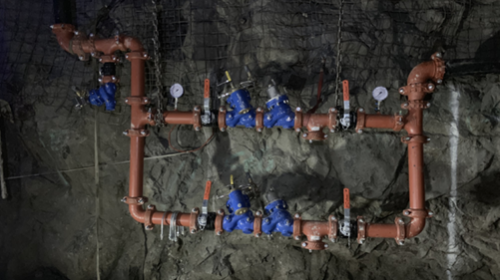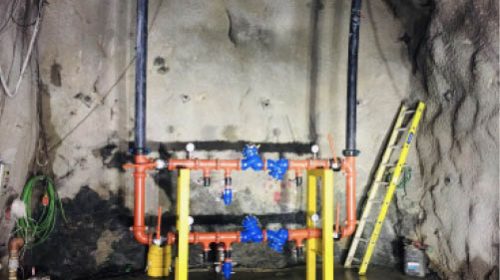Quarry Operations Can Maximize Productivity With Better Process Management.
By Marc Carriere and Wayne Johnstone

Effective water usage improves safety and profitability in mining operations but establishing a secure and reliable supply of process water at every level of a mine can be surprisingly difficult.
The absence of a dependable and consistent water supply has significant consequences. Variations in water volume and pressure can wreak havoc on equipment and piping, damaging machinery and causing leaks that halt production.
Downtime costs money, but it is unavoidable when valves, piping and equipment damaged by uncontrolled water flow have to be replaced or repaired, or when water must be remediated.
The fact is that even when operations are not interrupted, poorly designed process water-management systems impact profits to the tune of millions of dollars per year. In one recent incident, water shortages at one operation cost a mine more than $6 million in lost production.
Eliminating preventable losses is an important business practice at any time, but in the current market, which has been negatively influenced by such factors as the coronavirus pandemic, minimizing unnecessary expenses is particularly critical to sustaining profitable operations. Effective planning means controlling costs, eliminating unnecessary spending, and preventing lost revenue.
For mining companies, achieving consistent and reliable production can come down to improving their process water management strategy.
Identifying the Challenges
Managing process water is a challenge for every mine, and owners worldwide are well aware of the repercussions of large fluctuations in pressure, inconsistent water availability, and the aftereffects of broken pipes and flooding.
When water flows unpredictably, there are unavoidable consequences, and those consequences, in every instance, cause unplanned production loss. With a sufficient water supply available from the surface, suboptimal production due to water shortages in the mine should never occur, but this situation is all too common because the problem does not stem from the water source; it results from the inefficient flow of process water through the system.
While it is possible for mines to manage increases in water pressure by installing pressure-breaking tanks, the more common solution is to install pressure-reducing valves (PRVs) in PRV stations at increasing depths throughout a mine. A traditional installation allows water to flow through several PRV stations on its way down the shaft, a system known as a cascade system.
Most PRVs in use today are pressure regulating valves, which allow for the outlet pressure to be set and adjusted. Regulating PRVs often struggle with system pressure changes, sudden flow changes, and increasing water demand.
When a PRV has to work in these conditions, it tends to overshoot or undershoot the target pressure, and as the valve struggles to respond to water flow and pressure change, the valves surrounding it begin to do the same.
Valve hunting, a situation in which the valves cannot correctly manage pressure, in turn affects the water supply. When PRVs are installed in a series, as they are in traditional cascading systems, this problem is exacerbated.
Design
Unfortunately, significant as it is, valve hunting is not the only issue impacting water supply in a mine. The design of the pressure-reducing valve itself can be the root cause of flow constraints.
Ideally, only the actuator should be reducing pressure, not the valve body but at high flow volumes, the valve body can begin to act as a pressure-reducing valve. The consequence of this is restricted flow resulting in pressures far below the valve’s set point. Feeding an entire mine through these valve bodies can result in consistent water starvation.
Water starvation can have significant consequences, and the cause is not always the design of the valve body. Most mines rely on gravity systems to supply water underground.
In gravity-fed installations, water demand at the base of a mine can cause higher levels of the mine to experience substantial pressure drops. The longer the vertical pipe run, the greater the pressure. When pressure drops, water flow to revenue-generating equipment on higher levels can be compromised, creating devastating financial repercussions.
Historically, mine owners have used quick-fix solutions, but these stopgap fixes only deal with symptoms resulting from poor system design. When a mine owner addresses the immediate issue to bring the system back online but does not address the core design issues at the root of the problem, the same situation will occur again. The only way to solve these types of problems is to take a different, more holistic approach to process water system design – one that uses technology to address water management issues before they interrupt operations or cause damage to piping or equipment.
A Better Approach
Mine owners have started to deploy different types of valves to solve these costly process water management problems. System designs have begun to incorporate valves with specialized capabilities that eliminate fluctuating water pressure and availability issues and allow mines to operate at maximum efficiency at any depth.
These systems use ratio valves, which, until now, have been underused in underground mining operations. Unlike regulating valves that have a calculated output flow, ratio valves operate on a fixed ratio pressure, so there is no set pressure on the outlet side of the valve.
The first step in improving system design is to remove regulating PRV stations from the cascade system. In place of the regulating PRVs, a standpipe is created using ratio pressure reducing valves to control the column pressure, with regulating valves installed to feed operating levels.
The key is to separate the two systems. By creating one system for shaft piping and another method to supply the levels, mines can efficiently operate without the risk of valve hunting.
The use of ratio valves in shaft systems is proven to mitigate process water flow issues, but this does not fully solve the problem of water inconsistency throughout the mine. Within underground mining operations, every revenue-generating area of the mine must have an appropriate water supply.
For this reason, owners are now incorporating “priority valves,” to ensure that each location in need of consistent flow receives a steady supply of process water.

Proven Performance
Mines that need more effective water management now have a proven option for improving efficiency. Systems that include PRV stations with ratio valves are being installed worldwide for new shaft projects, shaft refurbishments, and in active mines where water management has proven to be a costly issue.
Once the flow issues are identified, components of the system can be arranged optimally for each application to deliver a customized solution that meets a mine’s unique needs, driving long-term efficiency and reliability.
Manufacturers of high-performance ratio PRV stations, regulating PRV stations, and priority valve stations offer prefabricated, pressure-tested units that can be installed quickly, mitigating the risk of field installation errors.
Using this modern process water-management strategy, mine owners can be confident that their systems will consistently function at peak efficiency. With these technologically enhanced systems, there is no need to continue to live with production losses caused by recurring process water management issues.
Marc Carriere and Wayne Johnstone are with Victaulic.
